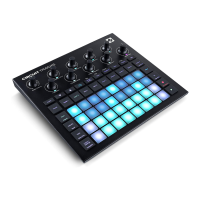16 17
Most of the remaining buttons select the 32-pad grid to display a specific View. Each View
provides information and control of a particular aspect of a particular track, pattern or sound
selection, timing adjustments, etc. Note also that several buttons have an additional ‘Shift’
function, indicated on (or above) the button by a legend in a smaller font.
Many buttons - including G Record - have both a momentary (long press) and a latching (short
press) mode. A long press will temporarily display that button’s view, but only while the button is
held down. When released the view will revert to whatever it was before the button was pressed.
A short press on a button will switch the grid view to that programmed into the button. The
Record button is a special case as it does not invoke an alternative grid display, but its momentary
action allows rapid punch-in and punch-out of Record Mode.
5
Track buttons: Synth 1 and 2/MIDI 1 and 2 /Drum 1 to 4 – these eight buttons select
different grid Views. Their operation varies slightly depending on other user actions.
6
Step buttons: Note, Velocity, Gate and Probability – these switch the grid to further Views,
and allow the parameters of each step of the pattern to be individually entered, deleted or
modified, for the currently selected track. Note that Probability is the Shift function of the
Pattern Settings button.
7
Pattern Settings – switches the grid to a View that allows adjustment of pattern length,
playback rate and direction for the currently selected track.
8
Step Page (1-16/17-32) – selects whether the Pattern for the currently selected track is
initially 16 or 32 steps in length. When a 32-step Pattern is selected, the colour of the button
legend changes when the sequence is running to indicate which “half” of the sequence the
grid is currently displaying. You can choose to have a 16- or 32-step Pattern on any track.
9
Scales – opens Scales View: allows the selection of one of sixteen different music scales for
the synth keyboard, and also lets you transpose the synth keyboard to a higher or lower key.
10
Patterns – opens Patterns View: lets you store multiple patterns for each synth, MIDI and
drum track, and to join them together to make a pattern Chain.
11
Mixer – enables the Mixer View, where you can mute or adjust the level of each synth, drum
and audio input making up the sequence, and also to pan each track across the stereo image.
12
FX – opens the FX View; lets you add reverb and delay effects to each synth, drum and audio
input individually.
13
G Record and H Play – these two buttons start and stop the sequence (Play), and enter
Record mode (Record). In Play mode anything you play on the grid will be heard; in Record
mode, anything you play will be heard and also added to the sequence.
14
Preset – opens the Preset View for the currently selected track. Each synth track can use any
of 128 Patches, each MIDI track can use any of eight MIDI templates, and each drum track
can use any of 64 percussion samples. The synth and drum Presets are arranged in pages of 32.

